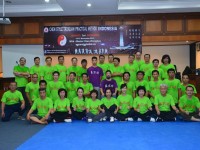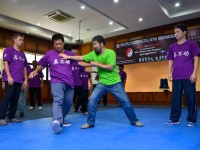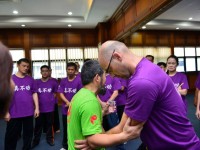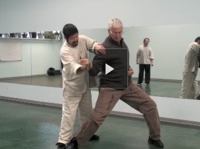Mat Beausoleil
By pushing with power and muscle you allow your opponent to control your entire body. Instead, issue with a rotation and a stretch so that no muscle power is used. This way your opponent cannot use your own energy against you.
This video describes the different energies that are applied in one move and how they work together to attack an opponent’s structure. If done properly, no muscle power or energy is used or wasted. This can only happen if the body is connected through correct stretching and rotations.
 I believe that what happens to a connected person’s body when being pushed can be understood by understanding how a trampoline works. Read more
I believe that what happens to a connected person’s body when being pushed can be understood by understanding how a trampoline works. Read more
 Any serious Taijiquan practitioner should develop the ability to listen and observe. Read more
Any serious Taijiquan practitioner should develop the ability to listen and observe. Read more
 If I were asked what I thought the key to learning Taijiquan was, I would have to say that it is the ability to break and change old habits, both physical and mental. Because habits are usually formed at a very young age and have gone unnoticed for so many years, most people are slaves to their habits. Bad habits are usually very difficult to identify and in most cases, nearly impossible to break. Like everything else, I feel that in order to be able to understand and deal with a certain issue, one needs to go deep into the mind and explore its roots and how it actually functions in the human psyche. Read more
If I were asked what I thought the key to learning Taijiquan was, I would have to say that it is the ability to break and change old habits, both physical and mental. Because habits are usually formed at a very young age and have gone unnoticed for so many years, most people are slaves to their habits. Bad habits are usually very difficult to identify and in most cases, nearly impossible to break. Like everything else, I feel that in order to be able to understand and deal with a certain issue, one needs to go deep into the mind and explore its roots and how it actually functions in the human psyche. Read more
 Once the student is more advanced and the process of opening up the body is well under way, the body will naturally start adopting many of the fundamental principles of Taijiquan. When the practitioner is able to demonstrate that his mind and body both have a good grasp of such things as connectivity, separation, differential in movement and spiraling, the body will be able to move in such a way that the limbs will be powered by rotations occurring in different parts of the body, much like a gearbox. Once this has been achieved, the next step is for the student to meticulously go through each move in the form and learn its applications. In this step of the systematic process, the student will be required to experiment with and refine all of his knowledge and understanding and start applying it to real situations. This will help consolidate and solidify the practitioner’s overall understanding of the different movements of the form as their function and purpose will progressively become clearer. This is the point where everything starts to finally make sense. Read more
Once the student is more advanced and the process of opening up the body is well under way, the body will naturally start adopting many of the fundamental principles of Taijiquan. When the practitioner is able to demonstrate that his mind and body both have a good grasp of such things as connectivity, separation, differential in movement and spiraling, the body will be able to move in such a way that the limbs will be powered by rotations occurring in different parts of the body, much like a gearbox. Once this has been achieved, the next step is for the student to meticulously go through each move in the form and learn its applications. In this step of the systematic process, the student will be required to experiment with and refine all of his knowledge and understanding and start applying it to real situations. This will help consolidate and solidify the practitioner’s overall understanding of the different movements of the form as their function and purpose will progressively become clearer. This is the point where everything starts to finally make sense. Read more
 Eventually, the positioning of the feet and stances must also be taken into consideration and perfected. When the body is properly connected, the legs are naturally brought in and the knees pushed out as far as possible without compromising the structure of the rest of body. Read more
Eventually, the positioning of the feet and stances must also be taken into consideration and perfected. When the body is properly connected, the legs are naturally brought in and the knees pushed out as far as possible without compromising the structure of the rest of body. Read more
 The circle, simply put, is the basis of every move in the Taijiquan Practical Method system. Every action or movement in the form is actually a part or variation of either the negative or positive circle. Therefore, common sense would suggest that one must gain a deep understanding of the circle and its mechanics in order to have any kind of understanding of Taijiquan and its practical applications. Read more
The circle, simply put, is the basis of every move in the Taijiquan Practical Method system. Every action or movement in the form is actually a part or variation of either the negative or positive circle. Therefore, common sense would suggest that one must gain a deep understanding of the circle and its mechanics in order to have any kind of understanding of Taijiquan and its practical applications. Read more
 Quality and quantity are two issues that come up a lot during training and seem to be the cause of some debate amongst practitioners. Generally most people have strong opinions about these two ideals and normally have specific training habits which clearly show which catergory they fall into. Read more
Quality and quantity are two issues that come up a lot during training and seem to be the cause of some debate amongst practitioners. Generally most people have strong opinions about these two ideals and normally have specific training habits which clearly show which catergory they fall into. Read more
 When the body becomes accustomed to moving through the forms in a connected way, the structure of the body will naturally begin to tighten up. As a result, the over exaggerated stretching movements previously used to open up and recondition the body should be adjusted and made smaller and tighter. Read more
When the body becomes accustomed to moving through the forms in a connected way, the structure of the body will naturally begin to tighten up. As a result, the over exaggerated stretching movements previously used to open up and recondition the body should be adjusted and made smaller and tighter. Read more
 It is a fact that most modern people, especially westerners living in urbanized areas, are not as physically active as they once were. As society becomes more dependent on machines and electric tools to do the physical labour once done manually, the bodies of modern men seem to be changing accordingly. Read more
It is a fact that most modern people, especially westerners living in urbanized areas, are not as physically active as they once were. As society becomes more dependent on machines and electric tools to do the physical labour once done manually, the bodies of modern men seem to be changing accordingly. Read more
 Eventually, higher level students of Taijiquan come realize that the power produced in practice should never be produced by the muscles. But if it isn’t produced in the muscles, where does the incredible strength, flexibility and speed of the great masters come from? I believe this question can be answered by understanding the amazing system of tendons and ligaments which connects the muscular and skeletal structures. Although many people like to believe that “qi”
Eventually, higher level students of Taijiquan come realize that the power produced in practice should never be produced by the muscles. But if it isn’t produced in the muscles, where does the incredible strength, flexibility and speed of the great masters come from? I believe this question can be answered by understanding the amazing system of tendons and ligaments which connects the muscular and skeletal structures. Although many people like to believe that “qi”
 It seems to me that most people are not aware of the spiraling that should occur throughout the body while doing Taijiquan. Even though most people must have seen the ancient diagrams of a body coiled in lines representing the spiraling paths of the silk reeling energy (chansijin) characteristic of Chen style Taijiquan, very few people seem to be able to explain or even understand what this principle actually is. Obviously, it is not only important to know how to create spiraling throughout the body, but also to understand why spiraling and the unique energy it creates is so important to the art.
It seems to me that most people are not aware of the spiraling that should occur throughout the body while doing Taijiquan. Even though most people must have seen the ancient diagrams of a body coiled in lines representing the spiraling paths of the silk reeling energy (chansijin) characteristic of Chen style Taijiquan, very few people seem to be able to explain or even understand what this principle actually is. Obviously, it is not only important to know how to create spiraling throughout the body, but also to understand why spiraling and the unique energy it creates is so important to the art.
 One concept which seems to come up in almost every lesson and principle Master Chen teaches is connection. But what does “being connected” actually mean? How do we achieve it and what are the benefits of being connected? I think these are all important questions that any serious Chen Style Taijichuan Practical Method student needs to explore and understand in order to gain a deeper understanding of this complex art. While most practioners seem to focus on the external choreography of the art, which is the first step and the foundation of the Yilu, I think the answer to what connection is can only be found by focusing on what happens inside the body. Taiji is, after all, an internal martial art!
One concept which seems to come up in almost every lesson and principle Master Chen teaches is connection. But what does “being connected” actually mean? How do we achieve it and what are the benefits of being connected? I think these are all important questions that any serious Chen Style Taijichuan Practical Method student needs to explore and understand in order to gain a deeper understanding of this complex art. While most practioners seem to focus on the external choreography of the art, which is the first step and the foundation of the Yilu, I think the answer to what connection is can only be found by focusing on what happens inside the body. Taiji is, after all, an internal martial art!





